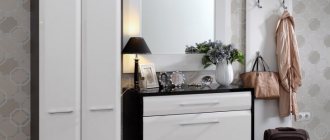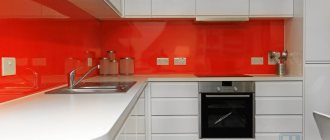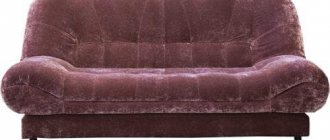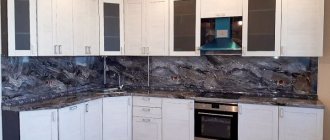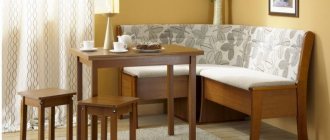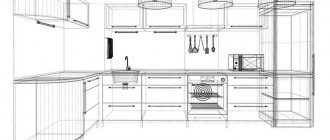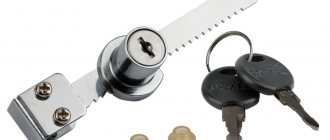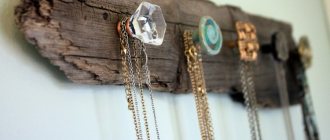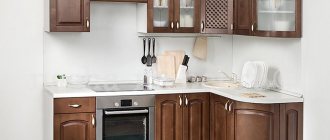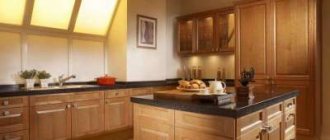/Order/
Cleaning the kitchen is serious business. Prepare your rubber gloves and enthusiasm - in this article we will tell you how to clean the kitchen at home easily and safely for finishing facades, countertops and aprons (including wooden ones!).
But, before you start choosing a recipe, we recommend that you familiarize yourself with the following universal rules and recommendations, which are relevant for both painted/unpainted wooden kitchens and laminated, varnished, plastic facades made of MDF and chipboard.
- For those in a hurry, we advise you to go straight to the recipes using the quick navigation (at the beginning of the article).
General recommendations
- The most important rule is: ALWAYS test the cleaner on an inconspicuous area before cleaning your kitchen. Treat it, then wipe clean and dry, wait 1-2 minutes and evaluate whether the color of the coating has changed, whether the shine has disappeared, etc.
- A greasy coating on kitchen furniture is a mixture of dust with fumes and a tiny suspension of fat that forms during cooking. The older the plaque, the more difficult it is to get rid of it. Therefore, the optimal schedule for “general” cleaning of the kitchen from grease is 1-2 times a year, “major” cleaning is every 2 months using mild products and, of course, when the need arises.
- To clean hard-to-reach areas, crevices, or decorative trim, use a toothbrush dipped in the cleaner from our article. You can also clean narrow crevices with a knife wrapped in cloth.
- Do not use harsh abrasives; only baking soda, a soft toothbrush, or the hard side of a regular foam sponge are acceptable. This is especially true for wooden kitchens, as well as any painted furniture without a top protective coating.
- When cleaning the kitchen, it is better to use a new sponge with a clean abrasive side. An old, greasy sponge can do even more damage.
- At the end of cleaning, it is advisable to wipe the kitchen: clean with a damp microfiber cloth and dry with a clean, dry microfiber cloth. This way you will avoid streaks and residues of the cleaning product itself.
- When cleaning the kitchen, pay special attention to the cabinets above the stove.
And now some special recommendations and warnings.
| For a wooden kitchen (painted with stain, enamel or other types of paint, unpainted but treated with oil/wax/polish/special impregnations/matte varnish, etc. | For all other kitchens: glossy, varnished, plastic, laminated and painted MDF and chipboard sets |
| A wooden kitchen requires the most delicate care. Most “folk” remedies like peroxide, ammonia, alcohol or citric acid are contraindicated for it, as well as ordinary alkali-based household chemicals. | Whether you use expensive or cheap household chemicals, the main thing is that it contains alkali. It is the one that most effectively copes with grease and dirt. |
| Manufacturers of wooden kitchens recommend washing facades only with special products with neutral Ph or a solution of warm water and soap (dishwashing detergent), diluted in a ratio of 5:95. But what if the Fairy solution does not remove old fat and stubborn stains? Ideally, thorough cleaning of the kitchen should be entrusted to special cleaning services, especially if the kitchen is relatively new, with expensive finishes. Our recipes are in most cases safe for wood, but there is still some risk in them. | It is convenient to use a spray bottle to clean the kitchen. |
| When wiping the kitchen, try to move along the grain of the wood, and not against or across. This will allow you to better clean the pores of the material and act more delicately on the fibers. | Before applying cleaning agent to the contaminated area, moisten it, for example, using a spray bottle. Moisture will speed up the chemical process somewhat. reaction and will make cleaning easier. |
| The rag should not be too wet. Excess moisture is harmful to wooden surfaces. | |
| After washing and cleaning wooden furniture, do not forget to treat it with protective wax, oil or polish. |
Cleaning greasy walls at home
The walls in the kitchen are more likely to get dirty than in other rooms of the house. Drops of fat are especially visible near the stove and sinks. Cleaning vertical surfaces is not easy. It all depends on the wall covering material.
Tile
Tiled walls can be easily cleaned with warm water and ammonia. For 1 liter take 2-3 tablespoons of ammonia. You can wash it by adding drops of glass cleaner, then the tiles will shine. At the end, the walls are wiped with suede.
Dye
On painted surfaces, you can remove stains with soapy water or vinegar. Solvents must not be used, otherwise the walls will have to be repainted.
Paper wallpaper is cleaned with a rubberized cloth, then vacuumed from top to bottom. Dry cleaning foam suitable for coverings made from natural fibers.
Whitewash
Do not clean whitewashed walls with a damp sponge or cloth. Grease and other stains should be removed by dry cleaning.
Using a Steam Cleaner
On all surfaces that are not afraid of moisture, it is better to remove all stains with a steam cleaner. The device will allow you to quickly cope with cleaning. Under the influence of temperatures, the fat dissolves and can only be removed by wiping with a damp cloth.
Household appliances, floors and other surfaces
Kitchen cleanliness is not only about removing stains from furniture and walls. When tidying up the room, they clean the floor, sinks, stove and household appliances. Washing methods are not much different from each other. They use both detergents from the store and what is on hand: vinegar, mustard, ammonia.
Paper towels
It is better to wipe off a fresh drop of fat or oil immediately using a napkin or paper towel.
Use a damp object to remove streaks of dirt and grease on walls, doors, and countertops.
Soap, soda
Stainless steel appliances are washed with soap and water without soda. It is better to wash stains on the floor with soapy water and sprinkle baking soda on problem areas. Then apply a sponge or soft brush soaked in clean water and wipe dry.
Hydrogen peroxide
A solution of hydrogen peroxide removes any dirt, soot, or oil stains. You need to mix peroxide with soda. The paste is applied to the surface, washed off after 20-30 minutes.
Melamine sponge
A melamine sponge is convenient because the material emits foam when moistened. The product can be used on any surface, removing stubborn stains. Melamine particles should be cleaned off with a dry cloth at the end.
Method 1. Express cleaning and polishing for advanced cases (soda + vegetable oil)
PURPOSE: wooden UNpainted kitchens and countertops (coated with matte varnish, oil, wax, polish, any impregnations), varnished and laminated kitchens made of MDF and chipboard, aprons made of any materials.
This recipe is especially helpful if you need to bring an old kitchen or countertop back to life with minimal time and money.
- With its help, you can, firstly, easily remove tightly adhered drops of fat, plaque and stains. Secondly, to “seal” the pores of the wood, protecting it from moisture and dirt. And thirdly, to give the facades a natural shine and brightness. Essentially, this old homemade recipe replaces both cleaner and furniture polish.
CAUTION: Painted wood kitchens and light wood kitchens (oil may yellow slightly).
CLEANING FREQUENCY: It is important that cleaning with soda-oil cleaner is carried out regularly - at least every 2 months. The fact is that oil tends to oxidize and lose its protective properties, possibly changing color.
INSTRUCTIONS:
Step 1. Mix 1.5 tablespoons of baking soda with 1 tablespoon of vegetable oil (you can use more in a ratio of 1.5:1).
Step 2. Apply the resulting “scrub” to contaminated surfaces, paying special attention to cabinets in the stove area. The soda will crumble a little, and the oil will be absorbed like polish. You will see that the tree will become cleaner and a little brighter before your eyes.
Step 3: Wipe treated areas with a clean, damp microfiber or soft cloth.
Step 4. Wipe the remaining cabinets from dust and light dirt with a damp cloth. If necessary, you can treat the entire kitchen with an oil-soda solution.
Rules of application
Shake the bottle of liquid before use. Then spray from a distance of 20 centimeters onto stains or streaks of fat. The gun or bottle must be held vertically.
Before spraying, it is worth testing the cleaning concentrate on a small area of furniture that is not visible to the eye. If the reaction of the façade material is negative, then another chemical is used to remove grease. It is advisable to put rubber gloves on your hands before cleaning and protect your mucous membranes with a mask. You need to use one product, without mixing it with others.
Method 3. Universal recipe for deep and thorough cleaning (6% vinegar + isopropyl alcohol)
PURPOSE: For general cleaning of old grease and other complex stains of painted and unpainted wooden kitchens, laminated, varnished, plastic glossy facades made of MDF and chipboard, all types of countertops and aprons.
CLEANING FREQUENCY: 1-2 times a year.
INSTRUCTIONS:
Step 1. Mix 6% vinegar with rubbing alcohol (isopropyl) alcohol in a 7:1 ratio and add a few drops of liquid soap to the solution.
Rubbing isopropyl alcohol can be purchased at outlets that sell printer supplies, companies that sell fiber optics, and specialty online stores. You should not experiment with other types of alcohol.
Step 2: Wipe the cabinets with the mixture using a microfiber cloth.
Step 3: Now wipe the kitchen clean with a cloth soaked in warm water.
Step 4. Finally, rub a special wood furniture oil that contains beeswax into all surfaces. This action will “seal” the pores and protect your kitchen from stains, dirt, moisture and grease for a long time.
Useful tips
You need to wipe the set and walls daily with a soft piece of flannel, plush, cloth or velvet. The constant use of wet wipes will make your cabinet look dull.
Lacquered surfaces will retain their shine if:
- cover them with wax;
- wipe with a mixture of glycerin and water;
- clean with a cloth soaked in milk.
Stains from brilliant green and iodine can be easily removed with a regular school eraser. Any surfaces in the kitchen can be easily washed with warm water and soap.
Source
Method 4. Ammonia + warm water
INTENDED USE: For all types of surfaces, but with great care for wooden surfaces.
CLEANING FREQUENCY: if necessary, but not more often than once every two to three months.
INSTRUCTIONS:
Add ammonia to warm water in a 1:1 ratio, then remove dirt with a sponge or spray the product from a spray bottle, wipe the treated area clean with a damp cloth. Finally, dry the surface with a dry soft cloth or microfiber cloth.
Method 5. Hydrogen peroxide + water
INTENDED USE: Only for kitchens, splashbacks and countertops made of MDF and chipboard. The product will help not only clean the kitchen of grease and dirt, but also disinfect the areas treated with it.
- It is permissible to clean a wooden kitchen with hydrogen peroxide, but only if you need to remove mold.
CLEANING FREQUENCY: If necessary.
INSTRUCTIONS:
Mix these ingredients in a 1:2 ratio, treat the desired areas with the resulting liquid using a rag (it is best to spray the product from a spray bottle).
Method 10. Removing fat using a steamer
PURPOSE: To remove old greasy deposits on all kitchen surfaces except wooden ones (!).
INSTRUCTIONS:
If you have a clothes steamer, then you can treat the entire kitchen with it, from the facades to the apron. The method is good for its simplicity and effectiveness. After such a “bath,” the kitchen should be wiped with soapy water and then with a clean, damp and dry microfiber cloth.
- It is advisable not to steam the edges, because this is the weakest point of any furniture made from MDF and chipboard.
Preventive measures
You can protect furniture from dirt if you take care of it, removing dust deposits in a timely manner and eliminating stains. It is advisable that:
- Keeping the kitchen moderately damp and dry will prevent the cabinets from cracking and staining.
- Try not to grab furniture doors with your fingers.
- Do not open coloring alcohol tinctures on unprotected countertops.
- Seal the cracks in the wood with beeswax in a timely manner.
- If lime or paint gets on the walls, immediately wipe it with a rag soaked in vinegar and vegetable oil.
By protecting kitchen items and taking proper care of them, you extend their service life.
Method 11. Removing complex stains using a melamine sponge
Surely you have already heard about melamine sponge or even tried it in action. This sponge consists of many thin melamine rubber fibers; like an eraser, it easily grabs and rolls off dirt from any surface. Contrary to myths, melamine miracle eraser is only harmful if ingested.
For this reason, we recommend not scrubbing interior shelves, drawers, and cabinets with a sponge. After cleaning, the crumbs must be carefully collected and all facades wiped clean. And, of course, the sponge should be kept away from children and animals.
PURPOSE: To remove old greasy deposits on all kitchen surfaces except wooden (!) and any countertops. Use with great care on painted facades - there are cases when the melamine sponge removed the paint along with the stains.
INSTRUCTIONS:
Wet the sponge in water, squeeze out excess moisture, then wipe the dirty areas with it. Carefully collect any accumulated dirt and discard it.
Steam cleaner
A steam cleaner (or steam generator) will remove remaining scale or oil traces, congealed grease, as well as fungus and foreign odors. Under the influence of temperature, old grease stains can be washed away. It can be used on all surfaces that are not harmed by moisture: glass, tiles, steel, wood - with caution. After treating the kitchen with a steam generator, it is enough to remove any remaining moisture and dirt with a napkin.

